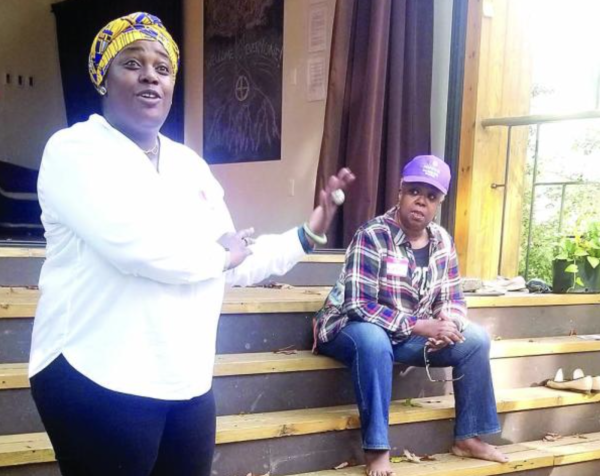July 28, 2022

Dananai Morgan (standing), a Neighborhood Birthing Center board member, and Dr. Jo-Anna Rorie, a consulting midwife on the project, during a fundraiser last fall in Jamaica Plain.
Photo courtesy of Nashira Baril
For women who are able and willing, and they are increasing in number, there’s no place like home when it comes to giving birth to their bundles of joy.
To some, the notion no doubt is a throwback to another time, or maybe a risky decision, but for more and more women – particularly those of color – the option of a home birth has become quite popular.
Practitioners and home-birth advocates in Dorchester and Mattapan have gathered quite a bit of steam in the wake of Covid-19 precautions and the growth of the home birth movement. All say the option is safe and practical for women who meet the health requirements.
Stephanie Johnson of Dorchester, the only licensed Black midwife in the state, assists at approximately 45 to 60 home births per year in the area. With more attention being given to the shocking statistics around Black Maternal Health outcomes, and the gravitation away from hospitals during the pandemic, she said she has been busier than ever with home birth inquiries.
“The majority of our clients are Black women and people of color,” she said. “The main concern for about 95 percent of them is they don’t want to have a baby in the hospital because of how they are treated. Many feel like they aren’t listened to…They feel they are rushed through a system like a number instead of having a provider relationship being built with them. That’s where I come in.”
Nneka Hall, a full-spectrum doula (a supporter of women through pregnancy but not in delivery) from Mattapan and a member of the state’s Post-Partum Depression Commission, said women, particularly women of color, have moved rapidly during the Covid era to home birth.
“It started up most recently with Black people because of reports about Black Infant Mortality and the recent report the state put out this year,” she said. “We feel safer at home. That sparked a natural movement in the public. Then you couldn’t have your family in with you during Covid. You couldn’t have your doula. Women had to actually choose between having their spouse or their mothers in with them.”
That combination of things has led to new thoughts on giving birth, and particularly giving birth in one’s home or at a birthing center in the neighborhood. Women who investigate the matter quickly learn there are differences between a hospital birth and a home birth. First, insurance does not cover home births, so payment come out of pocket. Second, there are no pain medications given during the pregnancy, so that can be a negative for some. Third, a pregnancy must be low-risk and the mother must be healthy to qualify for a home birth.
However, all home birth providers abide by a hospital transfer protocol if things don’t go as planned, so the process is quite safe. Most importantly for many, a home birth process gives the expectant mother and family more attention, with average appointments lasting one hour rather than the 15-minute check-ups offered by hospital providers.
Reaching back to an earlier time
Though it all sounds new and innovative, home birthing is a throwback to the past. Most people were born in homes prior to the 1920s and 1930s when hospital births became prominent. In fact, many older homes in Dorchester and Mattapan feature “birthing rooms” at the front of the home – typically smaller rooms without closets attached by a door to the master bedroom.
Johnson and Hall explained that midwives were typically Black or Indigenous women, and they would deliver the baby in the home – where the mother would relax for several days while the community came around to support the new baby and its family.
Then the hospital system entered the picture.
“Midwifery was transferred down from one generation to another, but in the early 1920s and 1930s there was propaganda spread about midwives being unsanitary and not knowing what they were doing,” said Johnson. “The doctors came in and saw that they could capitalize on it and put this campaign out to make people fearful about births at home. Women with money, white women, were first and it trickled down to communities of color. It eradicated a lot of home-birth midwives for a long time.”
Hall said hospital births became en vogue, but the popularity came with the loss of community and the well-being of mothers.
“We’re really coming full circle on this,” she said. “Everyone had home births long ago, but hospital births were new and quaint and so everyone wanted one. They did not understand what they were giving up to have them…It’s not normal to give birth on Monday and be back to work by Friday.”
In the 1970s, home birth became popular again with the hippie generation, said Nashira Baril, a Lower Mills/Mattapan resident who is fighting to open Boston’s first Neighborhood Birthing Center. She grew up around home birthing as her mother was involved heavily in the movement, and Baril had home births for two of her children. She said more and more women of color, and also women from wealthier communities, are increasingly interested in the option of home birth or community birth.
“There are a lot of dominant narratives locking the idea of a hospital birth in place,” she said. “That’s shifting, though. Everyone has birth photographers now and there is more of a reclaiming and taking the power back in the birthing process. People are seeking us out because there are now conversations and there is more knowledge of the maternal health crisis, especially in communities of color.”
Yet another change related to Covid
A major shift in mindset came during the pandemicwhen people were afraid to go to the hospital to have a baby. Others were put off by the restrictions of not being able to bring loved ones and spouses into the delivery room. That put the burgeoning home birth movement on speed dial for a lot of women.
“Within six months, the phone calls started coming in,” said Johnson. “In the beginning these were women who weren’t necessarily talking about home birth…Home births require a low-risk pregnancy, and you have to be healthy. Home births usually come from a set population…These were women who were just afraid to be in the hospital.”
Things have slowed down on that front, but because of that moment in time, many more people have now been exposed to the notion of a home birth. That has also spawned Baril’s idea of having a community birthing center. She has investigated the idea for well over 10 years after having researched the maternal health crisis for the Boston Public Health Commission (BPHC), but it took off during the pandemic.
After having a fund-raiser in 2019 that took in $10,000, Baril saw in 2020 that the changes in society had trickled down to her community birthing center movement. In 2020 alone, they were able to raise $250,000 online, she noted.
“In October 2020, I looked at the books and said, ‘Oh my, people were really affected by the pandemic when giving birth. You couldn’t bring your partner or doula in with you. They quickly wanted another option. It just catalyzed us for later that year. I started working on it 50 percent of my time to really move it forward.”
Her effort has been buoyed by a $100,000 earmark in this year’s state budget sponsored by Rep. Brandy Fluker Oakley, who is fully supportive of Baril’s idea.
“I am so glad that we were able to secure funding for the Neighborhood Birth Center,” said Fluker Oakley. “In Massachusetts, Black birthing people are three times more likely than white birthing people to have an infant who dies by their first birthday, which means that 300 Black babies die in Massachusetts each year.
“This center will provide incredible services to so many residents in our region and will have a substantial impact on equity by improving the experiences of Black birthing people and their families,” she said.
Baril said it would take $3 million to open up the center, and so the state funding is not the end-all and be-all to the idea but gives them great leverage with funders. They are turning primarily to private philanthropy and a partnership with community groups like Vida Urbana/City Life. By approaching it as a collective, Baril said, the Neighborhood Birthing Center could find life very soon.
“We want to buy a building and put the building in a land trust,” she said. “Together, we think we’re poised to create a future with this model. We are better when we’re a collective. This idea is that we think we can create the future we want…You want to be transported to feel that this is the way health care, and giving birth, can be. We can demand power and ownership in the moment.”
Baril said they have agreements signed with a major hospital for emergency transfers, and with the current momentum they hope to open in 2023.
There are options
Hall and Johnson are very excited about Baril’s potential community birthing center and will support it –it’s yet another option for women in the community.
Neither are anti-hospital, and that’s something they stressed, as they would rather be a partner with the hospital community. However, they said they do want the home birth option to be respected more by the medical community. That’s something that hasn’t occurred in the past, but perhaps that is changing along with everything else.
“Even though it’s not the only answer [to Black maternal health issues], from what I’ve seen in the past year, hospitals and doctors are starting to see we do exist,” said Johnson. “Before Covid, you would mention home births and get every excuse going in the book…Hospitals are now seeing this as another option, and they see they may not be able to meet the needs of every person. There may be someone that needs that extra attention or handholding that they can’t get at the hospital.”
Hall said women should know there is an option for them out there other than the hospital, even if it’s an option they don’t or can’t pursue. “That’s not something a hospital will tell you…They don’t tell you all your options,” she said.
“Everyone should know they can have it their own way,” she continued. “You can have a home birth if you meet the requirements. It is an option.”
Villages:



